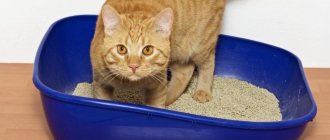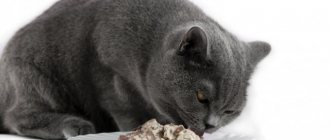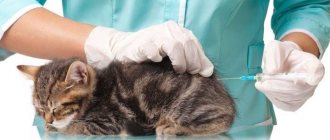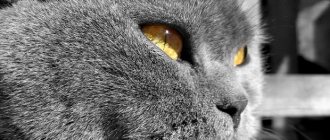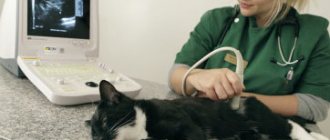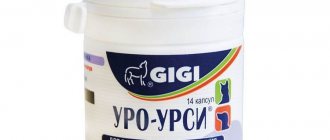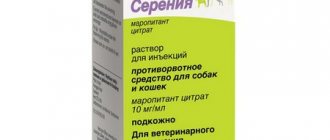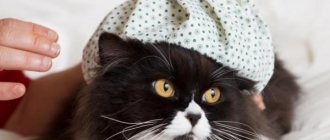The antimicrobial medical product “Furadonin” for cats is prescribed for diseases of the urinary system. This effective pharmaceutical product allows you to quickly return your pets to good health and rid them of infection. But before giving Furadonin to cats, you need to consult with an animal doctor - a veterinarian and read the instructions for use included with the medication.
Medicines for animals > Furadonin (tablets)
Brief description:
the active component of this antimicrobial agent is nitrofurantoin. Furadonin inhibits the vital activity of Proteus, Escherichia coli, hemolytic streptococcus, Shigella, Salmonella and some other microorganisms harmful to the animal body. Trichomonas are not sensitive to this remedy. When administered parenterally, the drug is in a therapeutic concentration in the blood within 30 minutes, and after 60 minutes in the animal’s urine, where it remains for at least 3 hours after use. The effect of this medicine is somewhat reduced in an alkaline environment, as well as in the presence of pus in the inflammatory focus.
Veterinarians prescribe this drug to animals for the treatment of inflammatory diseases of the urinary system caused by pathogens sensitive to nitrofurantoin. This remedy is also used to treat inflammation of the biliary tract. It is prescribed to chickens for pasteurellosis and infectious laryngotracheitis (conjunctival form).
For whom:
for mammals and birds.
Leave form:
the drug is available in the form of greenish-yellow enteric-coated tablets. Each tablet contains either 50 mg or 100 mg of nitrofurantoin, as well as excipients (potato starch, calcium stearate and aerosil).
Dosage:
The tablets are recommended to be given to animals along with food. The average daily dosage of this drug is 5-10 mg of nitrofurantoin per 1 kg of animal weight. It should be divided into 2-4 doses. The recommended duration of treatment is at least 7 days. The dosage of this remedy for minks for inflammation of the urinary tract and kidneys, as well as for urolithiasis, is 3 mg per 1 kg of animal weight. This dosage should be divided into 3 doses. To increase the effectiveness of treatment, veterinarians can additionally prescribe other antibacterial agents and vitamins for animals.
Restrictions:
This drug is highly toxic to chickens. Contraindications to its use are severe pathologies of the heart, kidneys and liver, as well as increased sensitivity of animals to nitrofurans. This medicine is prescribed with great caution to pregnant females. Side effects of such an antimicrobial agent are nausea, diarrhea, vomiting, drowsiness, and changes in blood composition. Its long-term use can lead to superinfection of the urinary tract caused by Pseudomonas aeruginosa.
Features of the disease
The disease has no age-related characteristics - both old and young animals, including puppies, are affected. A separate risk group is formed by small breeds and short individuals (dachshunds, for example). Bitches get sick somewhat more often than males due to the anatomical features of the structure of the genitourinary system.
In general, dogs get sick less often than cats, but have a more pronounced clinical picture.
It is very important to determine the exact cause of the disease, because only symptomatic therapy is a guarantee that the pathological condition will return, and next time it will manifest itself many times more strongly.
Symptoms of cystitis in dogs are acute and chronic. Chronic cystitis is a condition that develops against the background of some other primary disease. Its symptoms are diluted with clinical signs of another pathology, so it becomes difficult to make an accurate diagnosis. In acute cases, the symptoms are pronounced, and there are no difficulties with preliminary diagnosis.
According to its manifestations, bladder inflammation in dogs is classified into:
- catarrhal (the urine is cloudy, and protein is detected in the analysis);
- hemorrhagic (obvious presence of blood);
- dystrophic (externally the urine is practically unchanged, but tests reveal epithelial cells);
- purulent (the name speaks for itself - the presence of pus and an unpleasant odor leave no doubt about the form of the disease).
Furadonin
The active ingredient of this drug is nitrofurantoin. It can have an antimicrobial effect on the urinary tract. Nitrofurantoin acts directly on bacteria and disrupts the conductivity of their membranes, and also interferes with protein synthesis.
Furadonin is absorbed after entering the gastrointestinal tract and excreted by the kidneys. It is able to penetrate into the milk of a lactating cat and into the placenta during pregnancy. The drug gives a dark color to your pet's urine.
Excipients included in Furadonin:
The drug is available in blisters and glass jars. Any types of Furadonin are packaged in cardboard boxes. Usually the drug is available in tablets, but now a suspension has also appeared.
Main characteristics
"Furadonin Avexima" is an antimicrobial drug produced by pharmaceutical companies in Russia.
The medicine contains the active component nitrofurantoin, and each tablet also contains additional components - calcium stearate, starch, silicon dioxide.
Manufacturers suggest using tablets, as well as nitrofurantoin in powder or suspension form.
Adults choose the first option for administration, and children are given a suspension or powder. Packages contain 12-50 50 mg tablets - convenient if short-term or long-term therapy is required.
The active ingredient of the drug belongs to the nitrofuran group. Has a pronounced antimicrobial effect.
Nitrofurantoin is capable of disrupting the process of protein synthesis in the pathogen's body, increasing membrane permeability and prompt death of the pathogenic microorganism.
The drug is active against pathogenic microbiota - gram-positive and gram-negative microorganisms.
Such dangerous pathogens that nitrofurantoin neutralizes include streptococci, E. coli, staphylococci, shigella and many others.
Doctors consider it justified for use in patients suffering from infections of the urinary system.
Nitrofurantoin manifests itself in acidic urine; when the pH rises above 8, the activity of the drug decreases.
Despite the fact that Furadonin Avexima does not belong to the group of antibacterial drugs, it still eliminates pathogenic microflora from the body of a sick person. Used as a remedy for cystitis.
When taken, the drug is absorbed in the gastrointestinal tract; it is better to take the tablets with food, food improves the bioavailability of the drug.
Nitrofurantoin binds to plasma proteins, and the drug is metabolized in the liver and muscles.
The drug can break the blood-brain barrier, penetrate into breast milk and through the placenta. The drug is evacuated by the kidneys, half comes out unchanged.
Indications for use
Furadonin can be prescribed not only to cats or dogs, but also to birds. A veterinarian may prescribe it in the following cases :
- urinary system infections;
- pyelonephritis;
- cystitis;
- urethritis;
- acute cystitis;
- in preparation for urological operations;
- bacteriuria;
- paranephritis.
Can a cat have Furadonin for preventive purposes? Yes, but only before catheterization or operations on the genitourinary system. Before using Furadonin for prophylactic purposes, you should consult a veterinarian. Only a doctor can choose the correct dosage and duration of treatment. The drug is not addictive to the patient, but constant use of Furadonin by a cat is unacceptable.
This remedy is often prescribed to animals for urolithiasis. As a rule, an improvement in a cat’s condition occurs within 2-3 days after starting a course of Furadonin.
Analogues of the drug
For the treatment of diseases of the urinary system, analogues of “Furadonin” can be used:
- "Furagin";
- "Furamag";
- "Furasol";
- "Spilled."
“Furadonin” is a high-quality, inexpensive product that has a visible effect in the treatment of urolithiasis in cats.
Important! It is prohibited to replace medication during therapy without prior discussion with the veterinarian.
However, for greater effectiveness, it is important to have a high-quality, balanced diet during the therapy period, which the cat owner must take special care of.
Dosage
The amount of medication prescribed depends on the disease, as well as the weight and condition of the animal. Before administering the medicine, it is imperative to establish the exact body weight of the animal.
The course of treatment and dosage should be prescribed by a qualified veterinarian.
Cats usually eat the medicine well if given with a favorite treat or food that is palatable to the pet. If your pet refuses to eat the tablets, you will have to force them by placing them on the root of the tongue and closing the jaws.
Together with Furadonin, cats are often prescribed antibiotics. The drug is well compatible with them, but it is advisable to support the body by taking bifidobacteria. Also, during treatment, you can take a course of vitamins for cats with your animal . Sometimes, along with Furadonin, the doctor may prescribe other antibacterial agents.
Medicines to combat cystitis
Painkillers and antispasmodics
- analgin: 1 tablet/20-25 kg or 0.1 ml/kg body weight intramuscularly symptomatically, can be repeated only after 10-12 hours; Contraindicated for small dogs, puppies, as well as animals with severe kidney pathology;
- no-spa (drotaverine): 1 tablet/10 kg or in a solution of 1 ml/10 kg into the muscle. It is better to give it in tablets; they inject it when it is not possible to give a tablet.
Antibiotics
- Baytril 5%: 0.2 ml/kg intramuscularly for 3-10 days. Do not mix with tetracyclines and chloramphenicol;
- cefotaxime: twice a day at the same time, 15-20 mg/kg for up to 1 week (but not less than 5 days) by intramuscular injection;
- ceftriaxone: daily dose 20-40 mg/kg, divided into 2-3 doses at equal intervals, course duration 5-10 days;
- furadonin: dose per day 5-10 mg/kg of dog weight, which should be divided into 2-4 doses per day at regular intervals. Course: up to 10 days (but not less than a week).
Solutions for catheterization
- furacillin;
- saline 0.9%;
- 0.5% protargol or tannin;
- 3% boron solution.
All liquids should be close to body temperature. It is better to rinse more often and with small portions of liquid (from 5 to 25 ml, depending on the size of the dog) than once with a large volume.
Antihistamines
- suprastin: 1 tablet/medium dog, ½ tablet/small or puppy, 1.5-2 tablets/large individual;
- allervet 1%: 2-4 rubles/day. 1 ml/5 kg of weight (or 0.2 ml/kg) subcutaneously or intramuscularly until signs of allergic manifestations of the disease disappear.
Hemostatic drugs
- dicinone: 1 ml/10 kg weight per thigh. It is important not to exceed the dosage;
- vikasol: 1-2 mg/kg into muscle, maximum 3-5 days;
- calcium chloride: a maximum of 5-15 ml is administered intravenously (slowly), depending on the size of the animal. If it gets under the skin, the area should be injected with sodium chloride to avoid necrosis.
Homeopathy and herbal preparations
They are used only in combination with the main treatment.
- Cantarene injection: inject into the thigh muscle or subcutaneously into the withers 1-3 times a day for a week to ten days or until the condition returns to normal; for chronic cystitis - once a day for up to 1 month. Dose: 0.5-4 ml/animal, depending on size;
- kantaren tablets for cystitis: the duration of treatment is determined by the veterinarian, but not longer than 1 month; 2-3 times/day for severe forms, 1-2 times/day for mild forms; single dose 1-3 tablets/animal, based on its size;
- cantharis compositum: administered by any injection method at a dose of 1-4 ml/dog repeated every 24 hours until the condition normalizes in acute cases and every 4 days in chronic cases;
- urolex: give orally 1 hour before feeding, 3 drops/kg body weight 3 times/day. Give either immediately undiluted to the root of the tongue, or dilute in a very small amount of water and pour in using a syringe. The duration of treatment should not exceed 30 days;
- cystone: 1-2 tablets per day, equal to the body weight of the animal. You can take the entire dose at once, or you can divide it into 2 doses. The full course reaches 4-6 months if the cause of cystitis is stones, and up to 2 weeks of symptomatic therapy in other cases. Taking the drug is not advisable without an appropriate diet;
- stop cystitis for dogs (see instructions below).
Herbal infusions
- pain-relieving herbs: corn silk (you can’t give it for a long time!), peppermint and lemon balm;
- have a diuretic effect: knotweed, bearberry, oregano, horsetail, St. John's wort;
- relieve inflammation: licorice, St. John's wort, oak bark, birch buds, ginger, marshmallow root, parsley.
Different herbs have different properties. Decoctions are prepared from herbs of different groups for a complex effect. Take 1 part of any herb from each name, pour in 250 ml of boiling water, infuse in a closed container for 20-30 minutes, strain and top up to 0.5 liters of the total volume. Give up to 50 ml of herbal liquid twice a day, depending on the size of the animal.
Cats that should not use Furadonin
Not all cats can be given Furadonin; like any drug, it has contraindications. For example, the product is not used if the animal has an intolerance to one or more components included in the composition.
If you have cystitis, you cannot give Furadonin to a cat if it has the following diseases::
- renal failure;
- cirrhosis of the liver;
- heart problems;
- hepatitis;
- lack of B vitamins in the body;
- diabetes;
- anemia.
Also, Furadonin should not be given to small kittens and pregnant females.
During treatment, the owner must provide the pet with decent maintenance and balanced feeding, this will increase the pet’s chance of recovery.
Furadonin for cats
The antimicrobial medical product “Furadonin” for cats is prescribed for diseases of the urinary system. This effective pharmaceutical product allows you to quickly return your pets to good health and rid them of infection. But before giving Furadonin to cats, you need to consult with an animal doctor - a veterinarian and read the instructions for use included with the medication.
general information
According to the official instructions, the antibacterial drug Furadonin contains an active component - nitrofurantoin, the action of which is aimed at preventing the proliferation and death of pathogenic microorganisms.
The medicine is sold in the form of tablets intended for oral administration. For the treatment of infectious diseases in cats, Furadonin should be purchased in a dosage of 0.05 g. The activity of the antibiotic extends to salmonella, E. coli, streptococcal infection and many other pathogenic microorganisms. Nitrofurantoin acts directly on pathogenic agents: it disrupts the conductivity of their membranes and interferes with the synthesis of proteins. After the dose is taken, the active substance is absorbed into the gastrointestinal tract and excreted by the kidneys. The active component penetrates the placental barrier and into milk.
Cystitis in cats – Veterinary Service of the Vladimir Region
Cystitis is an inflammation of the mucous membrane of the bladder, as a result of the presence of an infection in the bladder or mechanical damage to the mucous membrane from urinary stones.
In cats, cystitis often occurs simultaneously with inflammation of the mucous membrane of the urethra - urethritis.
It occurs in all breeds of cats, regardless of their age. In cats, cystitis occurs more often, which is associated with anatomical features.
If in cats the urethra is short, straight and wide, which does not interfere with the free passage of salt crystals with urine, then in cats the urethra is longer, has two bends, plus a narrowing in the penis and prostate area.
Therefore, in cats, mucous and salt plugs often appear in it, leading to the cessation of urine secretion from the bladder.
Etiology . Most often, this disease occurs as a result of prolonged hypothermia. This usually happens to those cats who like to sleep on the windowsill with the window open or near the door (in places where there is active air movement).
As a result of complications in diseases of the genitourinary system: pyelonephritis, urolithiasis, damage to the urinary tract by parasites.
The presence of both internal and external parasites in the cat (fleas, ticks, lice eaters and helminths).
Parasites cause mechanical damage in cats in the area of the external genitalia, and given that the cat’s anus and urethra are almost very close, and when the cat begins to lick, the infection is carried through the urethra into the bladder. Additionally, parasites will release toxins that lead to metabolic disorders and the occurrence of secondary cystitis.
The cause of cystitis, which is difficult to treat, can be such widespread infectious diseases in cats as calcevirus infection, chlamydia, and rhinotracheitis. These infectious diseases are chronic and have a carrier form.
Mechanical damage to the urethra.
Improper feeding of a cat - lack of water when feeding a cat dry, overeating, imbalance in natural feeding, leading to an increase in salts in the urine.
As a result, the kidneys cannot cope with the process of filtration and elimination of toxins, swelling of the urethra occurs and the outflow of urine is disrupted, a sediment of salts and mucus forms in the urine, the urethra becomes blocked, and urolithiasis appears.
Predisposing factors for cystitis in cats are:
- circulatory disorders (stagnation, flushing) as a result of injury;
- the presence of inflammatory processes in organs close to the bladder
- secretion by the kidneys of substances (medicines) that irritate the mucous membrane of the bladder.
Pathogenesis . Products of inflammation of the bladder walls lead to changes in the composition of urine, in which pus, bladder epithelium, red blood cells and pieces of necrotic tissue appear.
As a result of microorganisms entering the bladder through a descending or ascending route, the urine rots.
The cat reacts to the inflammation of the bladder by increasing body temperature, and there is an increase in neuroreflex excitability of the inflamed mucous membrane, leading to frequent contractions of the bladder, as a result of which the cat begins to urinate frequently in small doses (sometimes in drops). Absorbed inflammatory products lead to a shift in the body's metabolic processes and intoxication. The number of leukocytes, especially neutrophils, increases in the blood.
Clinical picture . The cat has a frequent urge to urinate (the cat often sits on the tray or in another place). Sometimes after visiting the litter box, the cat crawls out of it on half-bent legs. We note frequent urination in small portions (sometimes a few drops).
When urinating, the cat experiences anxiety and pain. At the end of the act, the cat sometimes makes plaintive sounds. The smell of urine becomes pungent, ammonia-like or purulent. Mucus, crystals, blood, and pus appear in the urine. Sometimes there is a lack of urination.
Due to pain in the abdominal area, the cat very carefully turns over from one side to the other. The cat begins to refuse food, becomes thirsty, drinks a lot, and becomes lethargic and apathetic. An unreasonable increase in body temperature appears (above 39°C).
The abdomen upon palpation is very painful, tense and tight, and does not allow touching the abdomen.
In severe cases, the cat may vomit, swell the limbs, collapse, and coma.
Chronic cystitis is the result of acute untreated cystitis in kidney diseases (pyelonephritis, pyelonephrosis, infected hydronephrosis, bladder tumors, bladder stones, prostate tumors, urethral stricture, etc.).
Chronic cystitis in cats is manifested by the presence of blood in the urine. With chronic cystitis, hypertrophy of the muscle layer develops, as a result of which the bladder is not completely emptied of urine.
An accumulation of pathogenic microorganisms occurs in the bladder, leading to another attack of cystitis.
During laboratory examination of urine, depending on the severity of the inflammatory process, protein, mucus, epithelium, leukocytes, red blood cells, pus, blood, and salt crystals may be present in the urine.
During bacteriological examination, pathogenic microflora is isolated (Escherichia coli, cocci, streptococci, Pseudomonas aeruginosa, chlamydia, etc.).
The diagnosis of cystitis is made on the basis of anamnesis, clinical signs of the disease, results of laboratory tests of urine, clinical and biochemical blood tests, results of cytoscopy, results of an ultrasound examination of the abdominal cavity, results of an X-ray examination of the abdominal cavity. If cystitis of infectious etiology is suspected, appropriate laboratory tests are performed. In case of severe cystitis in a cat, the clinic’s veterinarian sometimes has to resort to double-contrast cystography or excretory urography.
Treatment . In each specific case, the clinic’s veterinarian prescribes treatment depending on the type of cystitis, general condition, and the presence or absence of urethral or ureteral obstruction in the sick cat.
In order to reduce the load on the cat’s kidneys and stop the increase in urine concentration, we remove food and provide plenty of fluids, as the liquid “flushes” the bladder.
If there is no blockage of the urethra, then to speed up the release of inflammatory products from the bladder, we give decoctions of herbs that have a mild diuretic and anti-inflammatory effect (lingonberry leaf, corn silk, bear's ear, bearberry leaves, horsetail).
The cat is provided with comfortable conditions and complete peace.
After the cat has managed to restore the outflow of urine, we resort to washing the bladder and urethra with antiseptic solutions (potassium permanganate, boric acid, furacillin, ichthyol, etc.) or saline solution (0.9% sodium chloride) in order to free the accumulated mucus, fine sand, blood clots and other cellular elements.
If, during a diagnostic examination, urethral obstruction is detected in a sick cat, then they resort to retrograde urohydropulsion, catheterization of the bladder, followed by fixation of the urinary catheter for a period of 5-7 days, urotomy or uretostomy.
After restoring the outflow of urine, the clinic’s veterinary specialist carries out symptomatic therapy, which includes relieving the inflammatory process and intoxication of the body, pain relief, and restoring the disturbed water-electrolyte balance in the sick cat’s body.
To relieve intoxication in a sick cat, use a dropper or inject 20 ml of Ringer's solution subcutaneously between the shoulder blades.
In case of bacterial acute cystitis, after preliminary titration of the pathogenic microorganism, antibacterial drugs are prescribed to antibiotics (baytril, ciftrioxone, cefatoxime, cobactan, cefkin, etc.), sulfonamide drugs (furagin, furadonin, furasemide, biseptol for children). Use according to instructions. The course of treatment is long, sometimes up to a month.
To eliminate the side effects of antibacterial drugs on the animal’s body, enterosorbents, probiotics, etc. are prescribed.
For colic and spasms, injections of antispasmodic drugs are used - analgin, cyston, no-spa, papaverine, baralgin, traumatin. For bleeding - dicinone. Homeopathic medicines – “Kanteren”, “Cat Erwin”. Immune correctors – gamavit, anandin, vestin, roncoleukin, immunofan, ribotan, fosprinil, etc.
Additionally, at the discretion of the attending physician, the standard treatment regimen used for cystitis can be supplemented with a therapeutic diet, giving special food that prevents urological disorders in cats (medicated food Royal Canin Urinary S/o), giving the cat antidepressants and sedatives.
A good effect is achieved by using Stop Cystitis for Cats, which contains components that help relieve inflammation, spasms and have antimicrobial and diuretic effects.
If cystitis in a cat is a consequence of urolithiasis, nephritis, diseases of the gastrointestinal tract, metabolism, etc., then it is necessary to begin treatment of the underlying disease that caused cystitis in the cat.
Prevention . Prevention of cystitis in cats should be aimed at preventing the causes leading to the development of cystitis. Owners should protect their cat from drafts and hypothermia, and prevent abdominal injuries.
Regularly carry out treatments against parasites, including deworming. Ensure proper feeding. The cat must be vaccinated against rhinotracheitis, panleukopenia, calicivirus infection and rabies.
Depending on the epizootic situation in the locality, they are additionally vaccinated against chlamydia and leukemia.
Vaccinations for kittens begin at 9-12 weeks. 10-14 days before vaccination, the owner must deworm his pet.
If a cat has chronic cystitis, then we give homeopathic medicines (Kantaren), Cat Erwin, etc. in a small amount of diuretic herbal decoction.
It is recommended to switch the cat to a diet with special food (Royal Canin Urinary).
Following the above recommendations will cause your cat to increase the rate of filtration in the kidneys, lead to a decrease in the concentration of salts in the urine and accelerate its outflow from the bladder.
Source: https://vetvo.ru/cistit-u-koshek.html
Instructions for use
Furadonin tablets are given to cats with food. Typically, the antibiotic dosage is 5-10 mg per 1 kg of pet weight, divided into 2-4 doses. The duration of the therapeutic course is on average 7 days. "Furadonin" can also be given for prophylactic purposes, for example, before surgery on the genitourinary system and before installing a catheter. The medication is not addictive in cats, but it is unacceptable to use it on an ongoing basis. A more precise dosage is determined by the veterinarian individually for each animal. As Doctor of Veterinary Sciences, Professor V.N. Denisenko describes in his scientific work of 2003, the first improvements when taking an antibiotic become noticeable already 2-3 days after the start of the therapeutic course.
What symptoms to look out for
- Increased urination. You can only notice it in pets who live indoors - he will constantly ask to go outside or make small puddles right in the room. The volume of urine produced per day does not increase: the dog goes to the toilet more often, but in small portions.
- Impurities appear in the urine: mucus, blood or pus. It becomes cloudy and acquires a sharp and unpleasant odor that is not typical for its normal state.
- At the time of urination or at the end of the process, the dog may whine in pain. Males stop raising their paws and urinate while crouching on both paws (a clear sign of cystitis). It is clearly evident that the procedure causes pain and discomfort for the pet.
- The dog does not allow you to touch the belly in the perineum - it twitches its paws, squats, whines and tries in every possible way to avoid inspection. The abdominal wall is tense, like the membrane of a drum.
- With a protracted process, general malaise, lethargy develops, appetite decreases, and body temperature rises. Signs of intoxication may appear at the time of development of the purulent process, because a sick animal will increasingly try to hold in urine in order not to feel pain.
- Cystitis in a dog has symptoms similar to urolithiasis - a more serious pathology that is excluded in the first place.
Possible restrictions
Before prescribing Furadonin to cats, the veterinarian must make sure there are no contraindications. It is forbidden to use the medicine for cystitis and other infectious pathologies in pets who are allergic to the antibiotic. You should not resort to therapy with Furadonin tablets for cats with anemia, diabetes mellitus, impaired renal function, and hepatitis. In addition, the medication is contraindicated for heart problems, deficiency of B vitamins in the body, and in the absence of urine entering the bladder. Furadonin is not used for the treatment of cats if they are less than 6 weeks old or are pregnant or nursing kittens.
When is it prescribed?
The disease is accompanied by an inflammatory process.
Veterinarians prescribe Furadonin to cats who have been diagnosed with the following pathologies:
- isolation of bacteria in urine;
- inflammation of the bladder, urethra;
- acute form of cystitis;
- infection of the urinary system;
- inflammatory process in the kidneys of bacterial etiology;
- purulent inflammation of the perinephric tissue.
Adverse reactions
A potent drug based on nitrofurantoin, when used correctly and regularly, is well tolerated and guarantees positive treatment success. If you neglect the recommendations of veterinarians, then the chance of developing side symptoms in pets increases significantly. In this case, the cat may experience nausea, vomiting, frequent loose stools, changes in blood composition, and drowsiness. In addition, anaphylactic shock, skin itching, pulmonary fibrosis, cough, refusal to feed, shortness of breath and joint pain may occur.
In exceptional cases, while taking Furadonin, cats experience vaginal discharge and, within the first hour after drinking a dose of the antibiotic, chills and fever. If signs of a negative reaction of the animal’s body to antibacterial therapy appear, it is necessary to suspend treatment and contact a veterinarian. The doctor will adjust the dosage or replace “Furadonin” with a drug similar in action, for example, “Furagino”, “Stopidar” or “Furazidin”.
Storage conditions
It is extremely important to store the antimicrobial agent correctly so that the tablets do not lose their effectiveness and do not change their medicinal properties. Therefore, the Furadonin package should be placed in a place where sunlight and moisture do not penetrate. If storage conditions are met, the shelf life of the medicine will be 2 years from the date of production. It is strictly contraindicated to give an expired pharmaceutical to cats; it must be disposed of.
Sources:
https://vet.apreka.ru/?p=furadonin_tabletki https://koshkamurka.ru/9429-kak-davat-furadonin-koshke.html https://infokotiki.ru/medicamenty/antibakterialnye/furadonin-dlya-koshek .html
Side effects
When treating a cat with Furadonin, side effects may occur. Here are the most common ones :
- skin itching;
- anaphylactic shock;
- allergic reaction;
- pulmonary fibrosis;
- cough;
- shortness of breath, difficulty breathing;
- refusal to eat;
- vomit;
- hepatitis;
- drowsiness;
- confusion;
- skin dermatitis;
- joint pain;
- weight loss.
© shutterstock
Sometimes cats experience vaginal discharge when taking Furadonin. Some animals develop chills and drug fever within an hour after taking the drug. This is possible even if the animal has not previously experienced allergic reactions.
If your cat begins to experience shortness of breath or difficulty breathing, you should immediately take it to a veterinary clinic. The doctor will provide first aid to the animal and cancel the recommendations for the use of Furadonin.


